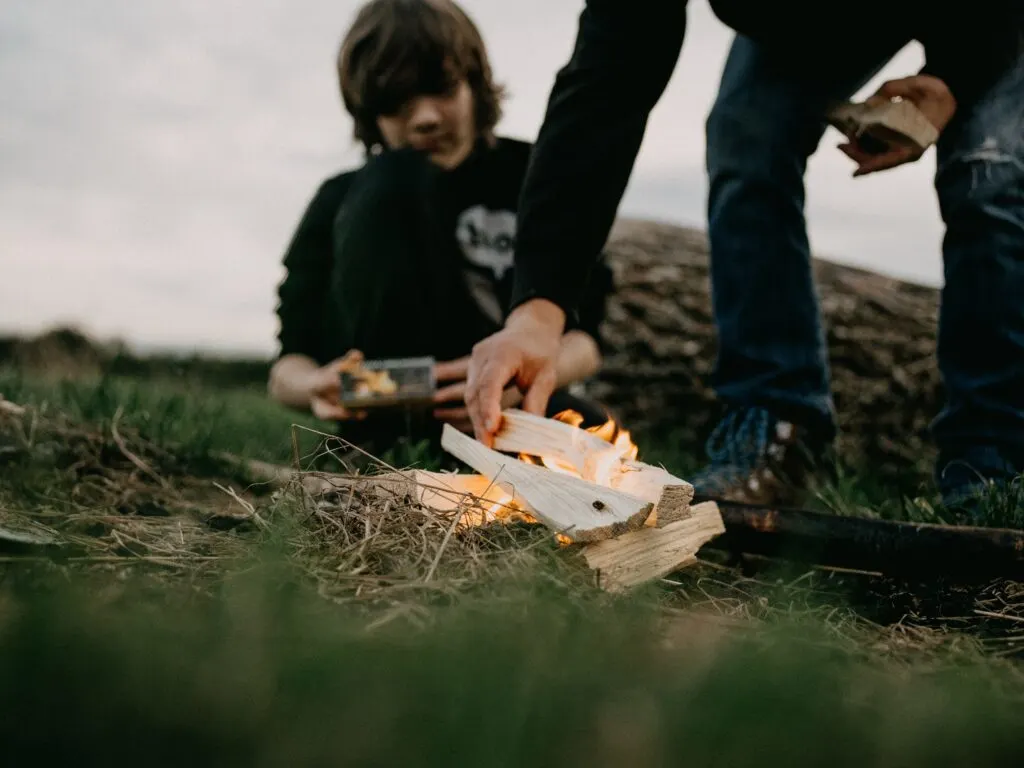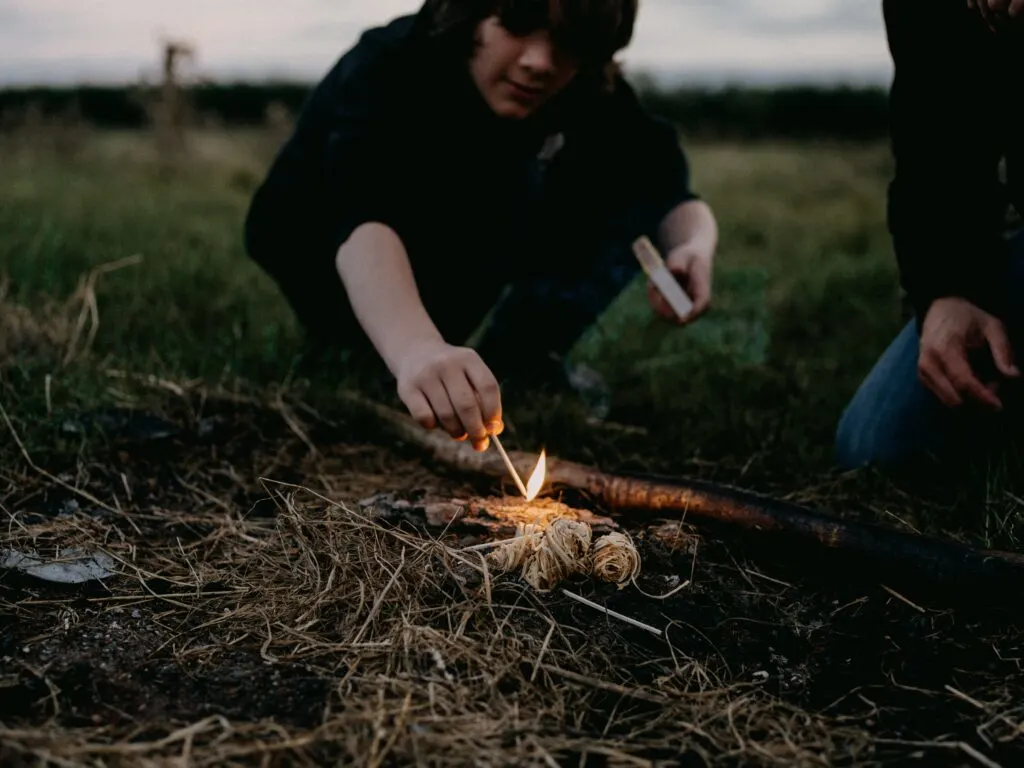What is Bushcraft?
If you are wondering what Bushcraft is, bushcraft is a skill that helps you survive in the natural world.
Why Should I Introduce My Children to Bushcraft?
These days, many children have limited access to the outdoors, and there is well-documented evidence about the harm that an increase in exposure to screen time can have on young children’s developing brains.
We know that too much screen time can be detrimental. The blue light emitted from electronic devices like mobile phones, TVs, computers, and tablets is addictive. Recent studies have proven that it can even be as addictive as a class-A drug – It’s no wonder we are all so attached to our devices.
The antidote is getting outside and exposing ourselves to as much natural light as possible. Being outside in nature can soothe the brain chemicals that cause stress and act like a natural antidepressant.
Even better – the adults can benefit just as much as the children, so what are you waiting for?
What Are the Benefits of Bushcraft?
There are many reasons why being out in nature and learning bushcraft skills are good for us.
- It increases our awareness of the natural world
- It increases our understanding of the seasons and different weather
- It makes us more connected to nature and automatically soothes us
- It can increase our respect for nature and the wildlife in our locality
- It can help to build up natural resilience and confidence
- It increases our ability to problem solve
I’m in! Where do I start?

Here is my beginner’s guide to bushcraft ideas for kids. You don’t need special qualifications or skills, but I would advise completing a risk assessment for each activity before starting.
A risk assessment will help you think through the risks, but we should also balance the risks against all the benefits you will gain. Consider the age and stage of the children you are working with, as each group will have varying needs; let’s get started.
1. Foraging
Foraging is a skill that has gradually declined as we spend more time indoors and less time in nature. Years ago, blackberry picking or hunting for chestnuts was a popular pastime, but the good news is, there is no reason why it can’t be again.
Foraging is a great way to connect with nature, work together for a real purpose, and even enjoy the fruits we collect. It’s a great activity if you want to get into bushcraft.
If you decide to go foraging, always check that you know what you are foraging for first. If you are unsure, leaving it there and being safe rather than sorry is better, as some mushrooms and berries can be poisonous.
2. Blackberry picking
Blackberries are probably the most popular fruit that can be safely foraged. Blackberries grow along hedgerows and in woodland areas—the best time to pick them is in August and September. Try not to collect blackberries from the side of a road.
Aside from being more dangerous to collect, they are more likely to be spoilt by pollution. If possible, follow the hedgerows in fields or woodland. It’s a good tip to wear gloves and tough clothing like jeans to prevent getting prickled by the thorns.
When you have collected your blackberries, try the following:
- Make blackberry and apple crumble
- Make a blackberry pie
- Freeze your berries to make a super Vitamin C smoothie
- Crush your blackberries to make natural paint
- Add a handful of blackberries to your mud kitchen
- Make detailed sketches of your blackberries
3. Chestnut treasures
If you are lucky enough to have a chestnut tree in your locality, go foraging in September and October, when the nuts will be ripe and falling from the tree. Ensure you collect the nuts from the ground, as they will automatically fall when ready to be eaten.
There is no need to knock them down from the tree. Wear gloves to gather the prickly little nuts and then take them home and roast them until they split open for a taste of days long ago.
4. Build a shelter
Building a shelter is not only great fun. It’s a skill that allows the children taking part to feel part of a team, and it builds natural confidence, resilience, and independence
You will need the following:
- Tarpaulins and blankets
- wooden poles
- ropes/string
- Pegs
Look for a sheltered spot and construct your shelter making sure it is waterproof. This is a good opportunity to learn how to tie knots to secure the shelter and to look for a spot that is high enough to be dry and flat enough to sleep on.
Think about the flooring you need and how you will secure the door to get in and out. Make sure it is weatherproof. You will need protection from all the elements, including the sun.
Alternatively, you can construct a conventional tent together, following the instructions.
There are a lot of skills to be learned in putting up a tent: working together, following instructions, perseverance, dexterity, and patience, to name a few.
5. Tracking
Tracking is a skill that has gone out of fashion, but it is a great opportunity to learn skills such as patience, observation, and discrimination. Tracking is looking at impressions in the ground to read their clues. This can include tracks in the snow, in the sand, in the grass, or mud.
Just think of the impressions a dog leaves behind when it runs across the sand on a beach. Looking carefully at those tracks can tell us many different things – The direction of travel, the dog’s size, even the speed it was traveling at.
You don’t need an environment full of wild beasts or bears to be able to track. You can track wildlife footprints like birds, squirrels, badgers, rabbits, mice, cats, and dogs.
It is worth spending a little bit of time thinking about the best place to find tracks before you start; for example, if you are tracking wild animals, think about where would be a safe place for them and where they would find water or food, and you will already be on your way to learning tracking skills.
Before you start, look at imprints, such as webbed feet, dog’s paws, blackbirds’ tracks, and rabbit’s feet, then look for soft ground like mud – not too dry and wet, to see if you can spot any recent tracks.
Remember, tracking is not just about footprints. Animals will leave other clues. They may make paths through the grass, tracks to their caves, or holes in banks.
Snakes are rare in the UK, but if you leave a large piece of corrugated iron or corrugated cardboard in a woodland and cover it over with leaves, there is a chance that if you return to it after a week or so, you may be lucky enough to see a snake slither away as you lift it off the ground.
6. Collecting firewood

Collecting firewood is an activity that everyone can participate in, regardless of age or ability, giving everyone a great sense of purpose.
A forest or woodland floor usually has plenty of debris, perfect for firewood. Branches of different sizes must be sorted, so start with a large log pile and a smaller kindling pile.
Make sure your kindling firewood is stored somewhere dry so that your tinder is flammable.
If you feel your children are ready to be introduced to tools, you can use small hacksaws to chop the larger branches into firewood, but make sure they know how to saw away from their hands and get into a secure position before they use a saw.
7. Navigation
In bushcraft, navigation means finding your way using skills other than technology. We rely heavily on technology today to get anywhere, but there are other forgotten ways of finding our way around.
Using a compass to navigate is one. Show the children the dial and teach them how to find:
North, south, east, and west. Start by counting outpaces in one direction and then turn to face another direction. Look closely at how the needle on the compass swings around to guide us.
Simple maps are another way to navigate. Depending on the age of your children, start with very simple maps with picture symbols and see if they can navigate using their compass to find their destination.
You can also talk about how explorers long ago navigated using the stars.
8. Cooking
Is there anything better in the world than cooking over a campfire and sharing delicious food when you have been out in the fresh air all day?
You don’t have special qualifications or be a forest school leader to make a campfire, but always risk assess your campfire before you start and have at least two adults available so that one can constantly watch the fire. You will need some ground rules when sitting around the fire.
Be clear that everyone should remain seated until told otherwise, and always ensure your fire is out once you have finished cooking. You can invite the children to pour water onto it, one at a time.
Here are some favorites to cook in the open air:
- Leek and potato soup
- Vegetable stew
- Sausages and beans
- Spaghetti hoops and bread
- And, of course, Smores – marshmallows toasted on forks then squashed between two biscuits
Have fun!
